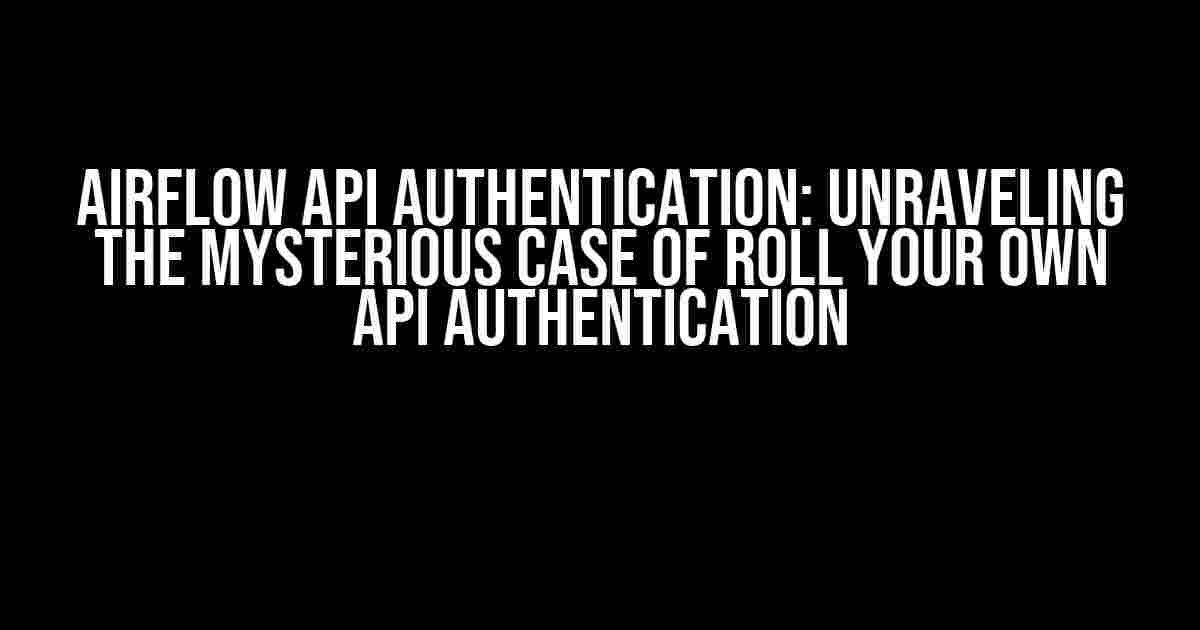Are you puzzled by the absence of the Roll Your Own API authentication feature in Airflow versions greater than 2.8.0? Fear not, dear reader, for we’re about to embark on a journey to uncover the truth behind this enigmatic phenomenon. In this article, we’ll delve into the world of Airflow, explore the Roll Your Own API authentication feature, and provide a step-by-step guide on how to configure API authentication in Airflow.
What is Roll Your Own API Authentication?
Roll Your Own API authentication, also known as “Custom API Authentication,” is a feature in Airflow that allows users to create and manage their own API authentication mechanisms. This feature was introduced in Airflow 1.10.10 and was available until Airflow 2.8.0. With Roll Your Own API authentication, users could write custom authentication code to authenticate API requests, providing a high degree of flexibility and customization.
Why was Roll Your Own API Authentication Removed?
As of Airflow 2.8.0, the Roll Your Own API authentication feature was deprecated and eventually removed. The primary reason for this removal was to simplify the authentication process and improve security. Airflow’s core developers realized that the custom authentication mechanism was often misconfigured, leading to security vulnerabilities. By removing this feature, Airflow’s developers aimed to promote a more secure and standardized approach to API authentication.
Configuring API Authentication in Airflow
Although Roll Your Own API authentication is no longer available, Airflow still provides several alternatives for configuring API authentication. Here are the steps to configure API authentication in Airflow:
Option 1: Basic Auth
Airflow supports basic authentication using usernames and passwords. To enable basic auth, follow these steps:
- Open the `airflow.cfg` file and update the `api.auth`
api.auth = airflow.api.auth.backend.basic_auth - Create a user with the desired username and password using the `airflow users` command
airflow users create --username myuser --password mypassword - Restart the Airflow webserver
airflow webserver restart
Option 2: OAuth
Airflow supports OAuth 2.0 authentication using external providers like Google, GitHub, and more. To enable OAuth, follow these steps:
- Install the required OAuth backend package
pip install airflow[oauth] - Configure the OAuth settings in the `airflow.cfg` file
[oauth]
provider = google
client_id = YOUR_CLIENT_ID
client_secret = YOUR_CLIENT_SECRET
- Restart the Airflow webserver
airflow webserver restart
Option 3: Kerberos
Airflow supports Kerberos authentication for large-scale enterprise environments. To enable Kerberos, follow these steps:
- Install the required Kerberos package
pip install airflow[kerberos] - Configure the Kerberos settings in the `airflow.cfg` file
[kerberos]
ticket = /path/to/kerberos_ticket
keytab = /path/to/kerberos_keytab
- Restart the Airflow webserver
airflow webserver restart
Troubleshooting API Authentication Issues
Encountering issues with API authentication in Airflow? Don’t worry! Here are some common problems and their solutions:
| Error Message | Solution |
|---|---|
| 401 Unauthorized | Check the username and password, and ensure that the user exists in the Airflow database. |
| OAuth error: invalid_client | Verify the OAuth client ID and secret, and ensure that they are correctly configured. |
| Kerberos authentication failed | Check the Kerberos ticket and keytab, and ensure that they are correctly configured and accessible. |
Conclusion
In conclusion, although Roll Your Own API authentication is no longer available in Airflow versions greater than 2.8.0, Airflow still provides a range of alternative authentication options. By following the steps outlined in this article, you can configure API authentication in Airflow and ensure a secure and standardized approach to API requests. Remember to troubleshoot any issues that arise, and don’t hesitate to reach out to the Airflow community for support.
airflow API authentication, simplified.
Happy Airflowing!
Frequently Asked Question
Get the inside scoop on Airflow’s API authentication feature and its availability in different versions.
Is the “Roll your own” API authentication feature available in Airflow versions greater than 2.8.0?
No, the “Roll your own” API authentication feature is not available in Airflow versions greater than 2.8.0. This feature was deprecated in Airflow 2.0 and removed in Airflow 2.3.0. You can use alternative authentication methods like OAuth, Kerberos, or LDAP instead.
Why was the “Roll your own” API authentication feature deprecated in Airflow 2.0?
The “Roll your own” API authentication feature was deprecated due to security concerns and the need for more robust and standardized authentication mechanisms. Airflow developers wanted to provide more secure and scalable authentication options, leading to the introduction of new authentication methods.
What are the alternative authentication methods available in Airflow?
Airflow provides several alternative authentication methods, including OAuth, Kerberos, LDAP, and others. You can choose the one that best fits your organization’s security requirements.
Can I still use the “Roll your own” API authentication feature in Airflow 2.0?
Although the “Roll your own” API authentication feature is deprecated in Airflow 2.0, you can still use it by setting the `api.auth_backend` configuration option to `airflow.contrib.auth.backends.default`. However, please note that this feature will be removed in future versions, and it’s recommended to migrate to alternative authentication methods.
How do I configure OAuth authentication in Airflow?
To configure OAuth authentication in Airflow, you need to set the `api.auth_backend` configuration option to `airflow.contrib.auth.backends.oauth`, and then provide the necessary OAuth settings, such as the client ID, client secret, and authorization URL. You can find more detailed instructions in the Airflow documentation.
